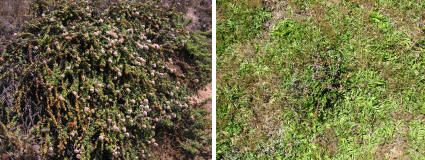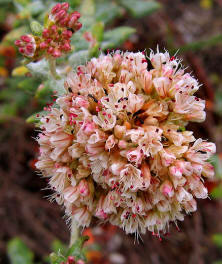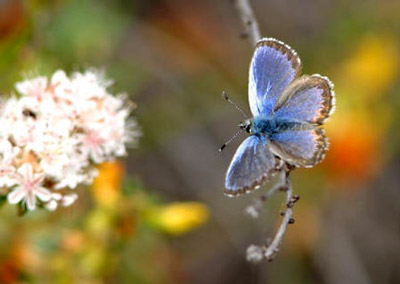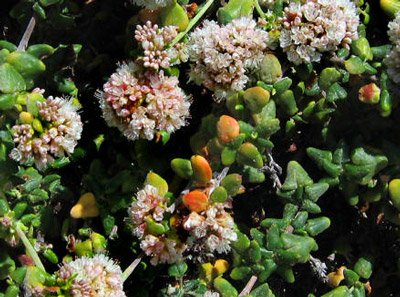Euphilotes enoptes smithi
- Endangered – Endangered Species Act (1976)
In 1948, while exploring the Big Sur coast, two university students discovered a previously unknown small blue butterfly. When one of the students, Claude Smith, died a few years later, his friend named the butterfly after him, and it’s still officially known today as Smith’s blue butterfly.
This tiny little butterfly, with a wing diameter of only one inch, thrives only on specific coastal dune, prairie and scrub habitat along an 80-mile stretch of coast in Central California. More than half of the butterfly’s range is within the Los Padres National Forest. With the loss of 50% of its habitat, Smith’s blue butterfly became one of the first insects to be recognized as an endangered species, in 1976.
Smith’s blue butterfly depends entirely on two species of buckwheat as host plants during all stages of the butterfly’s life: coast buckwheat and seacliff buckwheat. The butterfly’s emergence is timed with the blooming of the buckwheat flower, starting in June. During its short, one-week lifespan, the butterfly feeds, mates, and lays eggs only on the flowers of these buckwheats. In exchange, the buckwheat flowers are pollinated by the adult butterflies.
Corresponding with the flowering of the buckwheat, the entire adult population of Smith’s blue butterfly is active only from June to September, during which time the butterflies fly around frantically looking for food and mates. When they find each other, males and females will engage in a brief courtship in which they flutter their wings on top of the buckwheat flowers. After mating, the female butterfly lays a single egg in the flower head of the buckwheat. After hatching, the caterpillar feeds on the buckwheat flowerheads for several weeks, during which time it is tended by native ants. The ants protect the caterpillars from predators and parasites like wasps and spiders, and receive a sugary liquid in return. After several weeks of feeding, the caterpillar then spends the next 47 weeks in the chrysalis form, attached to the buckwheat plant or protected in the leaf litter. They remain dormant for the winter, awaiting next spring’s bloom of the buckwheat, when the process begins all over again.
Threats
Most experts agree that the number one threat to Smith’s blue butterfly is the disappearance of its coastal habitat, 50% of which has been lost to development, roads, invasive species, and other threats. Its dependence on seacliff and coast buckwheat makes the butterfly especially sensitive to invasive plants like iceplant, European beach grass, and yellow-star thistle which outcompete and smother native buckwheat plants. Other threats to Smith’s blue butterfly include off-road vehicle use, road building, sand mining, road and trail maintenance, and wildfire suppression.
On the Los Padres National Forest, commercial livestock grazing is of particular concern, as cattle can trample native seacliff buckwheat, crush butterfly chrysalises buried in the leaf litter, and spread weed infestations. In 2005, the Forest Service authorized livestock grazing on several allotments along the Big Sur coast. Federal biologists estimate that 20% of the seacliff buckwheat in these allotments are in areas “likely to be affected” by livestock grazing. The biologists ordered the Forest Service to carefully monitor the impacts of grazing.

Seacliff buckwheat not affected by livestock grazing (left). Seacliff buckwheat on the Gorda grazing allotment on the Los Padres National Forest (right), its growth stunted by cattle browsing and trampling, can barely be distinguished from the 2″ tall grass surrounding it.
Conservation
Smith’s blue butterfly was placed on the endangered species list in 1976, and federal biologists proposed to protect the butterfly’s critical habitat in 1977. However, this critical habitat was never officially designated. The US Fish and Wildlife Service, moreover, has no definitive knowledge on population size or trend for the species. The US Fish and Wildlife Service did issue a Recovery Plan for the Smith’s blue butterfly in 1984, but that plan has not been updated since then and federal biologists now consider it to be “obsolete.”
 The Los Padres National Forest has not undertaken any comprehensive surveys of Smith’s blue butterfly on the Monterey Ranger District. Despite these lack of surveys, the Forest Service continues to approve activities like commercial livestock grazing that could adversely affect the butterfly.
The Los Padres National Forest has not undertaken any comprehensive surveys of Smith’s blue butterfly on the Monterey Ranger District. Despite these lack of surveys, the Forest Service continues to approve activities like commercial livestock grazing that could adversely affect the butterfly.
All hope is not lost for the butterfly, however, as there have been a number of efforts in recent years to alleviate the threat of invasive species along coastal bluffs and dunes, restore native habitat, and protect butterfly habitat from additional impacts. The California Park Service, US Fish and Wildlife Service, and a host of non-profit organizations are working to remove non-native plant species, replace them with local natives, and create corridors of buckwheat so that the butterflies can disperse up and down the coast, restoring their former range. Restoration efforts include the designation of the first insect-based preserve in the US, at the site of the former Fort Ord in Monterey County. On national forest lands, ForestWatch is working to ensure that the Forest Service fulfills its obligations to monitor and report the effects of livestock grazing in Smith’s blue butterfly habitat, and to protect the butterfly from harm.








